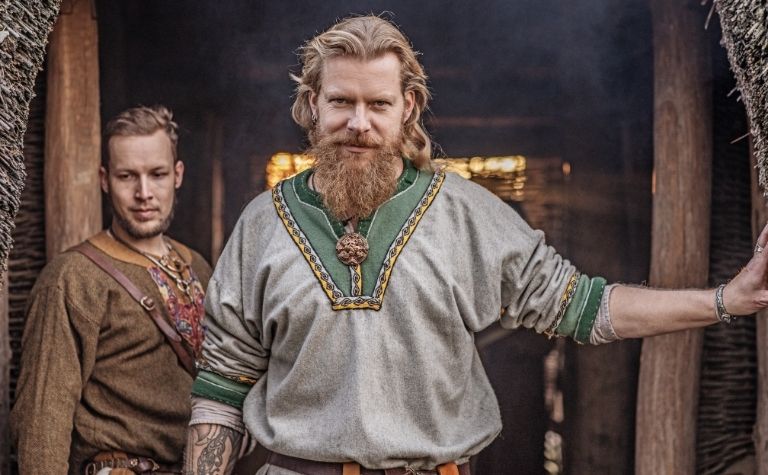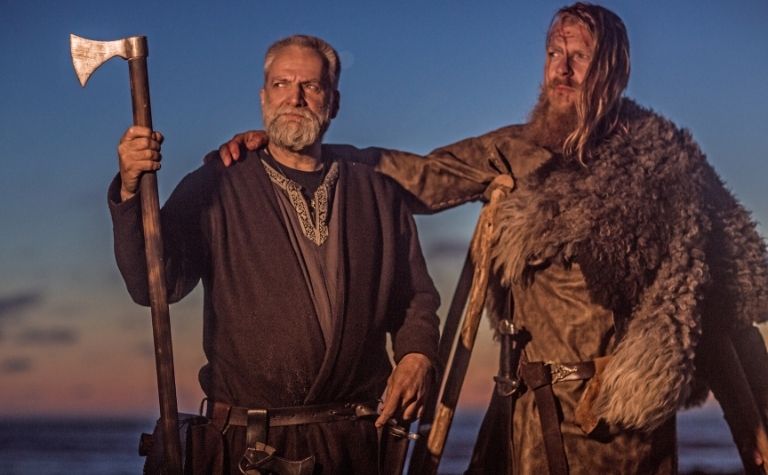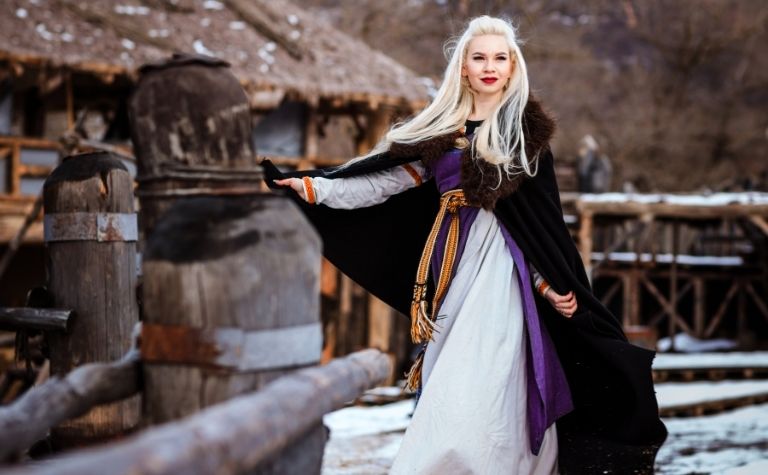Upon mentioning the word Viking, most people imagine a troop of burly, blonde, blue-eyed seafarers making a trek in a longboat.
However, this image is only partially accurate, as the Vikings were explorers, and along their journeys, they mixed with and welcomed many people from other European areas.
The Vikings had various eye colors, although the predominant eye color was blue or gray.
However, Irish Vikings had predominantly brown or hazel eyes, and some Viking settlements were much more diverse than others.
Although there were many blue-eyed, blonde-haired Vikings, as their territories expanded, trading routes developed, and immigrants came in, the Vikings became more and more diverse.
By the end of the Viking Age in 1066 CE, those who had been given a traditional Viking burial were as diverse as the modern populations of Norway, Denmark, Sweden, and the rest of Europe.
Also see What Did the Vikings Actually Look Like? to learn more.

How Common Were Blue Eyes Among the Vikings?
Blue eyes were very common among Northern Vikings, while brown eyes were more common in the Viking settlements of England, Ireland, and mainland Europe.
In modern times, most people who claim to be of Viking descent have blonde hair and blue eyes, but that doesn’t mean that all Vikings shared this appearance.
The best evidence scholars have for the phenotype of the Vikings comes from a 2020 genetic study published in Nature. [1]
In this study, researchers took DNA samples from the remains of over 400 people in Europe who were given formal Viking burials.
According to the results, most of the deceased had mixed heritage, especially those in the southern and westernmost tips of the Viking world.
Even more had DNA that included a mixture of Scandinavian and non-Scandinavian heritage, although people of these genetic mixes were concentrated in isolated communities.
Surprisingly, some of these buried individuals had no Scandinavian heritage, although they were buried with Viking jewelry, blades, and equipment. [2]
Most of these individuals were Scottish, which leads to interesting inferences.
The researchers suggested that these burials were evidence that becoming a Viking had little to do with genetic heritage and more to do with cultural identity.
This study proved that Vikings lived in isolated communities that were still open to intermarrying and expansion.
As they made new alliances and settled new territories, Vikings became more and more diverse.
Likewise, some people from nearby areas may have adopted the Viking name, although they had no Scandinavian ancestry.
The most common eye color depended on where a person lived as a Viking and the genetic descent of those who first settled the area at the beginning of the Viking Age.
Irish and English Vikings predominantly had brown hair and brown eyes. [3]
Those from Denmark typically had red hair and blue or green eyes. Others from Sweden and Norway primarily had blue eyes.
Few people in history have spread the same way that the Vikings did.
For example, during the study, the researchers found that one of their subjects, buried in Oxford, England, was the brother of another subject buried in Denmark.
So, although existing evidence for the phenotype of Vikings is only limited to around 450 bodies and little literary evidence, it is clear that Viking peoples spread, intermarried, and found new homes where they mixed with the locals, bringing their traits with them.
Also see 5 Traditional Female Viking Hairstyles to learn more.

Why Do Many Characters on the TV Show Vikings Have Blue Eyes?
Many characters on the TV show Vikings have blue eyes because most people associate Scandinavian heritage with blue eyes and blonde hair.
In addition, the writers of Vikings use eye color as symbolism for a character’s divinity, health, and intentions.
Many of the prominent characters in Vikings were real people, though Vikings often fictionalized their deeds.
Ragnar Lothbrok, for example, does many things in the show that never happened in history.
Of course, even the original tales of Ragnar weren’t necessarily true.
Instead, he became more of a legendary figure as Medieval writers continued to tell tales of him, likely stretching the truth as the fables traveled through time and space.
For example, the 13th-century Saga of Ragnar Lothbrok tells of how Ragnar slew a dragon.
However, scholars can gather some facts from these tales.
According to these stories, Ragnar was a Danish king who took a significant part in the diversification and expansion of the Danish Viking territories.
Although these accounts never describe Ragnar’s physical characteristics, Ragnar was likely red-haired with blue or green eyes based on the average phenotype of Danish Vikings.
The casting directors of Vikings likely chose actors with blue eyes due to stereotypes and the lack of historical evidence for the actual appearance of Ragnar and the many people he interacted with.
Since most people of pure Scandinavian heritage and most Danish Vikings had blue eyes, the safest way to attempt historical accuracy was to cast blue-eyed people.
In addition, during the first two seasons of Vikings, editors used CGI effects to enhance some of the characters’ eye colors, giving their blue eyes more depth and brightness.
Although the show’s writers have never made such claims, it is plausible that this vibrant blue ties into Ragnar Lothbrok’s claimed descent from Odin.
Many Viking kings claimed a similar lineage, and according to myth, Odin had eyes as bright as the blue sky.
Since religion plays a significant role in the show, the brightness of Ragnar’s eyes may be a means of emphasizing his divine heritage and his capacity as a warrior.
Also see Were There Black Vikings? to learn more.

What Color Hair Was Common Among Vikings?
The most common hair color among Vikings was blonde. Western Vikings in Danish areas had red hair, while Vikings from the north primarily had blonde hair.
However, those from Scotland, Ireland, England, and settlements in Southern Europe predominantly had brown hair.
Based on Nature’s genetic study, Vikings from various regions had different physical characteristics.
Although the most recognized Norwegian and Swedish Vikings may have had predominantly fair hair, those from the other areas had different hair colors.
However, some evidence suggests that many darker-haired Vikings may have bleached their hair with highly acidic soaps.
Vikings were often well-groomed and bathed more frequently than many other Medieval peoples, so they may have used washing to lighten or redden their hair, just as the Celts did.
Whether this coloration was intentional or simply a byproduct of cleanliness, some Vikings with genetically dark hair may have appeared much fairer-haired in person.
Conclusion
Although most Vikings had fair complexions, Viking settlements were diverse, and many Vikings had dark or red hair and brown eyes.
Also see Why Did the Vikings Die Out? to learn more.
